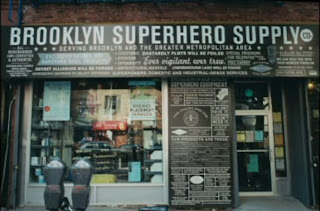
Ted Eggers is a writer and many of his friends and family got into teaching, the problems with students not achieving goals was lack of teachers. The classes could consist of 30-40 kids and they would have several classes a day, there wan no time for one to one tutoring at all.
At the same time as Ted Eggers was getting a building on a retail street for a publishing company with other writers. The idea was to with his fel
low friends and writers start up a tutoring center for kids after that could drop in after school. The writers and other volunteers would stop working at 2.30pm and help devote some time to each kid.
The problem was that it was on a r
etail street so they had to sell something and they decided to make it into a store selling pirate gear. This was due to while renovating they d
iscovered that the store looked as a ship underneath the previous design of the store.
There was a problem in the start to get kids in the store, as people didn't know what it was, even though it was free 1to1 attention. Research say that 1to1 attention can give kids at least a grade better. Kids would run into the space eventually. Ted Egger believes because it is not called 'center for kids with specials needs school' something happens when the kids come into this exciting space, which is very much like school essentially. About sixty kids came in per day.
There was about 12 volunteers to start of with, then 40, 200 and now 1400. It is very easy to become a tutor as you can do it

for only a couple of hours per month, which is wh
y it grew so quickly. The shop/center/publishing store became very popular in the community and the sales of pirate gear became so successful that they could pay the rent and staff with it.
Local schools contacted them and offered them a classroom too. They also published a book with kids' essays which was sponsored and sold around the world. The kids worked harder than ever and about 170 tutors worked on the stories.
'if the kids know that their written word will be saved and published they will work harder than they ever had and with 5-6 drafts they will learn so much and will reach a level that they will never leave.' - Dave Eggers
Local teachers, donors and others came in to look at the 'store' serving the local community and the idea was lifted to N.Y Brooklyn and L.A and other cities. The spirit of selling something that was very specific and funny was transfered to the other branches. And the tutoring center was at the heart of it all. Local workers, designers, builders was pro bono.
'It was a happy accident'

A specific case study is 9 year old Khaled Hamdan 9, Brooklyn who
came in as he couldn't focus at home. He has now been published in 5 books and did a public readin
g i
n front of 500 people. He got addicted to finishing his homework so that he knew he would be prepared for school the next day.
The success of the project is obviously the
dedication and goodwill of all those who volunteered to help out, but I was caught by the transformation that happened to the kids when entering something that wasn't labeled school. A place that may have negative connotations. Especially for kids that react neagtively to the word school as soon as they hear it. The relaxedness and choice to go there in the first place is one thing, but the design of the place is also affecting the kids. Labeling the space in which you have to learn is perhaps a negative thing. If it is not labeled as school it seems different, exciting, something that stimulates imagination and creativity.
Just look at these inspiring branches that started started in N.Y and L.A


No comments:
Post a Comment